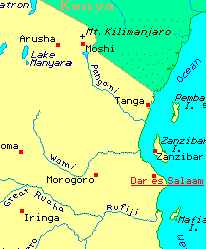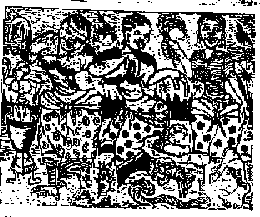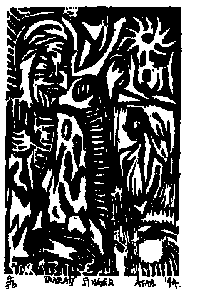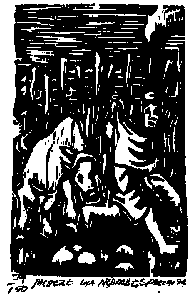New Age of ZanzibART
3 young artists from Tanzania
Hashim Abdi
Salum Muchi
Asaa Hamad
Part1
1996.3.25�$B!J�(JMon�$B!K�(J----4.3�$B!J�(JWed�$B!K�(J
11:00am--6:30pm *3.25 from3:00pm�$B!"�(J4.3 to 5:00pm
Gallery TOMOS
Watanabe Buil B1,1-3-1 Nihombashi-honcho Chuoh-ku Tokyo
tel:03-3271-6693 fax:03-3242-3075
From 2:00pm We have discussion with Mr.Hashim about "Tanzania art scene"
*3.31(Sun)Closed
Metro ginza line "Mitsukoshi-mae"
Part2
1996.3.25�$B!J�(JMon�$B!K�(J----3.30�$B!J�(JSat�$B!K�(J
11:30am--7:00pm *3.30 to 5:00pm
Gallery 21+YOH
Chery Buil B1,3-4-17 Ginza Chuoh-ku Tokyo
tel&fax:03-3567-2816
Metro ginza line "Ginza"
Part3
1996.4.6�$B!J�(JSat�$B!K�(J----4.17�$B!J�(JWed�$B!K�(J
11:00am--7:00pm
Shohmeidoh Hall
Shohmeidoh B1,Near the Takanodai St. Kodaira Tokyo
tel:0423-41-1455 fax:0423-41-9634
From 3:00pm Mr.Hashim tells "Me and Shetani,Swahili spirit cult complex"
Seibu Kokubunji line"Takanodai"
3 Young artists from Zanzibar
 Our three young artists came from Zanzibar, a small but populous island
with a population of 400,000, set in the Indian Ocean. It is the fourth
largest city in the United Republic of Tanzania, well known for
Mt.Kilimanjaro and Ngorongoro Natural Park, a paradise of wild animals in a
huge crater.
The people of Zanzibar had already started trading with Arabs or
Indians in the first century A.D. Their close relationship with the Arab
makes the peculiar character of their culture different from the inland
areas of Tanzania.
The three artists we welcome now teach atNyumba ya Sanaa , a national
arts and crafts school founded in 1987 with the help of Japan Overseas
Cooperation Volunteers. All of them are in their twenties with short careers
as serious artists, but perhaps because of their youth and inexperience,
they have prodeuced works of rare beauty, showing their confidence in art
and the pleasure of creation.
Our three young artists came from Zanzibar, a small but populous island
with a population of 400,000, set in the Indian Ocean. It is the fourth
largest city in the United Republic of Tanzania, well known for
Mt.Kilimanjaro and Ngorongoro Natural Park, a paradise of wild animals in a
huge crater.
The people of Zanzibar had already started trading with Arabs or
Indians in the first century A.D. Their close relationship with the Arab
makes the peculiar character of their culture different from the inland
areas of Tanzania.
The three artists we welcome now teach atNyumba ya Sanaa , a national
arts and crafts school founded in 1987 with the help of Japan Overseas
Cooperation Volunteers. All of them are in their twenties with short careers
as serious artists, but perhaps because of their youth and inexperience,
they have prodeuced works of rare beauty, showing their confidence in art
and the pleasure of creation.
Hashim Abdi( b.1969�$B!K�(J
 Among the three, only Hashim has visited Japan, invited to the award
ceremony of the Third Sapporo International Print Biennale Exhiition 1996, as a
winner of the silver prize.
Though 95 percent of the Zanzibari are Muslim, the folk religion still
persists among them. The heroes and heroines of the folklore, "Shetani" (from the same
root as "Satan") are the dead, but they are believed to be enjoying a life
like ours. They are capricious and mischievous toward us and can be seen
only by sensitive people, or only when we become highly sensitive.
Hashim continues drawing on the narratives of Shetani like a sorcerer, and
he says it is natural and quite the same as drawing on his everyday life.
Surely he is not a socerer by any means, but an ordinary young Zanzibari,
loving reggae and Whitney Houston.
Among the three, only Hashim has visited Japan, invited to the award
ceremony of the Third Sapporo International Print Biennale Exhiition 1996, as a
winner of the silver prize.
Though 95 percent of the Zanzibari are Muslim, the folk religion still
persists among them. The heroes and heroines of the folklore, "Shetani" (from the same
root as "Satan") are the dead, but they are believed to be enjoying a life
like ours. They are capricious and mischievous toward us and can be seen
only by sensitive people, or only when we become highly sensitive.
Hashim continues drawing on the narratives of Shetani like a sorcerer, and
he says it is natural and quite the same as drawing on his everyday life.
Surely he is not a socerer by any means, but an ordinary young Zanzibari,
loving reggae and Whitney Houston.
Asaa Hamad( b.1969�$B!K�(J
 It is not well known that Zanzibar was governed by the sultan of Oman from
the nineteenth century until 1964, the year of the revolution. "Taarb", the
unique pop music of Zanzibar came from the court music of the sultan and has
come to express true sentimentality of the common people. The concerts are
popular especially among Muslim women who go rarely out of their home.
Taarb gives them an occasion to dress up and congregate, and represents
their true voices.
Assa takes up as his thems Taarb concerts and its rhymes, most of which
deal with love. However, his drawings are ironically decorative and
reminiscent of the interior ornaments of Islamic mosque.
It is not well known that Zanzibar was governed by the sultan of Oman from
the nineteenth century until 1964, the year of the revolution. "Taarb", the
unique pop music of Zanzibar came from the court music of the sultan and has
come to express true sentimentality of the common people. The concerts are
popular especially among Muslim women who go rarely out of their home.
Taarb gives them an occasion to dress up and congregate, and represents
their true voices.
Assa takes up as his thems Taarb concerts and its rhymes, most of which
deal with love. However, his drawings are ironically decorative and
reminiscent of the interior ornaments of Islamic mosque.
Salum Muchi( b.1967�$B!K�(J
 Muchi the oldest of them and can be called the leader of the group.
He is a kind of story-teller about the common people's lives, having
silently drawn on various scenes of everyday life: festivals, weddings,
often sorcerous rituals. These traditional events have gradually
disappeared or changed in the modernization of Zanzibar.
Muchi also depicts tumultuous markets or outside disco parties that are very
familiar to young Zanzibari. In his prints, we can certainly see how
Zanzibar is now, how a region of Africa is now.
Muchi the oldest of them and can be called the leader of the group.
He is a kind of story-teller about the common people's lives, having
silently drawn on various scenes of everyday life: festivals, weddings,
often sorcerous rituals. These traditional events have gradually
disappeared or changed in the modernization of Zanzibar.
Muchi also depicts tumultuous markets or outside disco parties that are very
familiar to young Zanzibari. In his prints, we can certainly see how
Zanzibar is now, how a region of Africa is now.
Shin-ichi Arai (Artist,ex-Teacher of Nyumba ya Sanaa,Zanzibar)
If you'd like to know more info,Please send me e-mail
arai@ppp.kabinet.or.jp
Home Page Our three young artists came from Zanzibar, a small but populous island
with a population of 400,000, set in the Indian Ocean. It is the fourth
largest city in the United Republic of Tanzania, well known for
Mt.Kilimanjaro and Ngorongoro Natural Park, a paradise of wild animals in a
huge crater.
The people of Zanzibar had already started trading with Arabs or
Indians in the first century A.D. Their close relationship with the Arab
makes the peculiar character of their culture different from the inland
areas of Tanzania.
The three artists we welcome now teach atNyumba ya Sanaa , a national
arts and crafts school founded in 1987 with the help of Japan Overseas
Cooperation Volunteers. All of them are in their twenties with short careers
as serious artists, but perhaps because of their youth and inexperience,
they have prodeuced works of rare beauty, showing their confidence in art
and the pleasure of creation.
Our three young artists came from Zanzibar, a small but populous island
with a population of 400,000, set in the Indian Ocean. It is the fourth
largest city in the United Republic of Tanzania, well known for
Mt.Kilimanjaro and Ngorongoro Natural Park, a paradise of wild animals in a
huge crater.
The people of Zanzibar had already started trading with Arabs or
Indians in the first century A.D. Their close relationship with the Arab
makes the peculiar character of their culture different from the inland
areas of Tanzania.
The three artists we welcome now teach atNyumba ya Sanaa , a national
arts and crafts school founded in 1987 with the help of Japan Overseas
Cooperation Volunteers. All of them are in their twenties with short careers
as serious artists, but perhaps because of their youth and inexperience,
they have prodeuced works of rare beauty, showing their confidence in art
and the pleasure of creation.
 Among the three, only Hashim has visited Japan, invited to the award
ceremony of the Third Sapporo International Print Biennale Exhiition 1996, as a
winner of the silver prize.
Though 95 percent of the Zanzibari are Muslim, the folk religion still
persists among them. The heroes and heroines of the folklore, "Shetani" (from the same
root as "Satan") are the dead, but they are believed to be enjoying a life
like ours. They are capricious and mischievous toward us and can be seen
only by sensitive people, or only when we become highly sensitive.
Hashim continues drawing on the narratives of Shetani like a sorcerer, and
he says it is natural and quite the same as drawing on his everyday life.
Surely he is not a socerer by any means, but an ordinary young Zanzibari,
loving reggae and Whitney Houston.
Among the three, only Hashim has visited Japan, invited to the award
ceremony of the Third Sapporo International Print Biennale Exhiition 1996, as a
winner of the silver prize.
Though 95 percent of the Zanzibari are Muslim, the folk religion still
persists among them. The heroes and heroines of the folklore, "Shetani" (from the same
root as "Satan") are the dead, but they are believed to be enjoying a life
like ours. They are capricious and mischievous toward us and can be seen
only by sensitive people, or only when we become highly sensitive.
Hashim continues drawing on the narratives of Shetani like a sorcerer, and
he says it is natural and quite the same as drawing on his everyday life.
Surely he is not a socerer by any means, but an ordinary young Zanzibari,
loving reggae and Whitney Houston. It is not well known that Zanzibar was governed by the sultan of Oman from
the nineteenth century until 1964, the year of the revolution. "Taarb", the
unique pop music of Zanzibar came from the court music of the sultan and has
come to express true sentimentality of the common people. The concerts are
popular especially among Muslim women who go rarely out of their home.
Taarb gives them an occasion to dress up and congregate, and represents
their true voices.
Assa takes up as his thems Taarb concerts and its rhymes, most of which
deal with love. However, his drawings are ironically decorative and
reminiscent of the interior ornaments of Islamic mosque.
It is not well known that Zanzibar was governed by the sultan of Oman from
the nineteenth century until 1964, the year of the revolution. "Taarb", the
unique pop music of Zanzibar came from the court music of the sultan and has
come to express true sentimentality of the common people. The concerts are
popular especially among Muslim women who go rarely out of their home.
Taarb gives them an occasion to dress up and congregate, and represents
their true voices.
Assa takes up as his thems Taarb concerts and its rhymes, most of which
deal with love. However, his drawings are ironically decorative and
reminiscent of the interior ornaments of Islamic mosque.  Muchi the oldest of them and can be called the leader of the group.
He is a kind of story-teller about the common people's lives, having
silently drawn on various scenes of everyday life: festivals, weddings,
often sorcerous rituals. These traditional events have gradually
disappeared or changed in the modernization of Zanzibar.
Muchi also depicts tumultuous markets or outside disco parties that are very
familiar to young Zanzibari. In his prints, we can certainly see how
Zanzibar is now, how a region of Africa is now.
Muchi the oldest of them and can be called the leader of the group.
He is a kind of story-teller about the common people's lives, having
silently drawn on various scenes of everyday life: festivals, weddings,
often sorcerous rituals. These traditional events have gradually
disappeared or changed in the modernization of Zanzibar.
Muchi also depicts tumultuous markets or outside disco parties that are very
familiar to young Zanzibari. In his prints, we can certainly see how
Zanzibar is now, how a region of Africa is now.